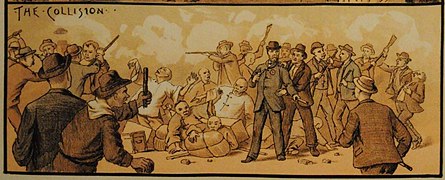1886年西雅圖反華暴亂
| 此條目翻譯品質不佳。 (2021年4月2日) |
| 1886年西雅圖反華暴亂 | |
|---|---|
 | |
| 位置 | 西雅圖 |
| 日期 | 1886年2月 |
| 類型 | 美國反中情緒、種族清洗 |
| 受害者 | 西雅圖華人 |
| 主謀 | 美國白人 |
| 動機 | 反華、種族歧視 |
1886年西雅圖反華暴亂(英語:Seattle riot of 1886)是一個種族清洗的反華事件,發生於1886年2月,在西雅圖當時的唐人街 [1] [2]。
背景[編輯]
19世紀中期中國人開始移民到美國西部從事於礦工與鐵路等苦力工作 [3] [4] [5]。 那時期華工在美國受到相當大的偏見與排斥,很多白人認為華人的低價勞力會壓低他們自己的工資或搶他們的工作 [6] [7] [8]:88。
從1873年開始,美國進入了長期蕭條。美國工人對「中國佬」的偏見也更加高,美國反中情緒也越激烈 [9]。「美國勞工聯合會」是當時反華的主要組織之一 [10]。
1877年三藩市反華暴亂之後,加州工人工會於加利福尼亞州成立,該工會的口號「中國人必滾!「(The Chinese must go!)傳遍美國西部 [11]。在華盛頓州,另一個工會「勞工騎士團」也利用此口號來組織反華活動 [12]。
1882年美國國會通過美國排華法案,停止華人移民十年 [13]。
1882年,北太平洋鐵路開始在太平洋西北地區興建一條鐵路線。這工業在華盛頓領地總共僱用了15,000華工,因此華人也開始搬入西雅圖 [14]:283。他們大部份聚居於第二 、第三街與華盛頓街周圍,那裏便形成了一個唐人街 [15]。
1885年的西雅圖華人估計為950人,大約是該市人口的10% [16]。
1885年9月2日石泉城大屠殺爆發,9月7日史夸克谷也發生華人謀殺事件。這些新聞更加激動了西雅圖的反華分子 [17]:99 [18]:365。
暴亂[編輯]
1885年9月28日,「勞動騎士團」在西雅圖Yesler's Pavilion召開了一個「反華代表會」(Anti-Chinese Congress),塔科馬市長雅各布·魏斯巴赫(Jacob Weisbach)選為主席[17]:99 [19]。 這個代表會決定要在11月1日之前把華人從整個華盛頓州西部驅逐[18]:366 [20]。
1885年11月3日,即11月1日的限期過兩天,1885年塔科馬排華事件暴發,市長魏斯巴赫是領導人物之一。這排華新聞很快就傳達西雅圖,那裏的華人便開始移出唐人街[19]。1886年2月西雅圖暴亂之前,一半以上的華人已經搬出西雅圖,剩下大約300-400人[16]。
1886年2月7日與14日,一群暴徒把剩下的大部份華人居民強迫運到碼頭,分別地逼上了兩艘輪船,趕去三藩市 [21]:160。
這場暴動結果使四人受傷,一人死亡[22] [23]。華盛頓領地州長Watson C. Squire為此宣佈戒嚴,美國總統格羅弗·克利夫蘭也派了聯邦兵隊來維持治安[17]:105[16] [24] [25] [26] [27]。
-
「收拾起來」
-
「在碼頭上」
-
「衝突」
暴亂後史[編輯]
這一連續的反華暴動發生之後,美國政府採取了一系列的排華法律,以減少在美的華人人口[17]:108。
1888年10月1日,美國國會通過斯科特法案,禁止華人在離開美國後再次入境 [28]。
1888年10月19日,美國國會向清朝政府付了276,619.15美元的賠款,以補償西雅圖驅逐華人和其他反華暴動案件[18]:383[1]:229 [22]。
1892年美國國會把1882年的美國排華法案延續了再十年,1902年又無限期的延長此法案。
1941年12月7日,珍珠港事件發生之後,美國加入第二次世界大戰,中國便成為美國的同盟國家。
1943年12月17日,為了促進雙國的友誼關係,美國國會通過麥諾森法案,放鬆了排華法案對華人移民的限制[13] [29]。
新的唐人街[編輯]

二十世紀之後,華人開始回到西雅圖居住。
1909年1月9日,清朝政府任華裔商人阮洽(Goon Dip)為西雅圖的領事 [30] [31] [32]。在那年的阿拉斯加-育空-太平洋博覽會,阮洽與另一位商人阿傾(Ah King)組織了當地的華人,建造了一個「中國村」(Chinese Village) [33] [34]。
1910年,阮洽在新建的國王街站附近造了一間豪華的「密爾沃基旅館」(Hotel Milwaukee) [35] [36],阮洽與阿傾也分別地僱用了大量的華人 [37]。這地區以後就成為西雅圖新的唐人街 [38]。2008年2月9日,新唐人街的第一個牌樓「中華門」建成 [39]。
二次世界大戰之後,其他亞洲人也開始移進新唐人街附近。這地區現在稱為「唐人街-國際區」(Chinatown–International District) [40] [41]。
-
密爾沃基旅館,1911
-
中華門,2008
參考文獻[編輯]
- ^ 1.0 1.1 Pfaelzer, Jean. Driven out: the forgotten war against Chinese Americans. University of California Press. August 2008: 400. ISBN 9780520256941.
- ^ 菲爾澤, 瓊. 驱逐(被遗忘的美国排华战争). 花城. 2016-08-01: 431. ISBN 9787536080508.
- ^ Taylor; Francis. McClain, Charles , 編. Chinese Immigrants and American Law. Routledge. October 1, 1994: 191–193 [2021-04-02]. ISBN 978-0-8153-1849-1. (原始內容存檔於2021-05-10).
- ^ Sayej, Nadja. 'Forgotten by society' – how Chinese migrants built the transcontinental railroad. The Guardian. Jul 18, 2019 [2021-04-02]. (原始內容存檔於2021-05-11).
- ^ Kennedy, Lesley. Building the Transcontinental Railroad: How 20,000 Chinese Immigrants Made It Happen. A&E Television Networks, LLC. May 10, 2019 [2021-04-02]. (原始內容存檔於2021-05-26).
- ^ Morgan, Murray. Puget's Sound: A Narrative of Early Tacoma and the Southern Sound. University of Washington Press. 1981. ISBN 0295958421.
- ^ Morgan, Murray; Lang, William L. Puget's Sound: A Narrative of Early Tacoma and the Southern Sound. University of Washington Press. 2003 [2021-04-02]. ISBN 0295983035. (原始內容存檔於2014-01-11).
- ^ Cross, Ira. VII: 'The Chinese Must Go'. A History of the Labor Movement in California. Berkeley, California: University of California Press. 1935: 88–129.
- ^ Brekke, Dan. Boomtown,1870s: Decade of Bonanza,Bust and Unbridled Racism. KQED. February 11, 2015 [2021-04-02]. (原始內容存檔於2021-05-02).
- ^ Saxton, Alexander. The Indispensable Enemy: Labor and the Anti-Chinese Movement in California. University of California Press. 1995: 271. ISBN 0520029054.
- ^ Huping Ling; Allan W. Austin. Asian American History and Culture: An Encyclopedia: An Encyclopedia. Taylor & Francis. 17 March 2015. ISBN 978-1-317-47644-3.
- ^ Schwantes, Carlos A. Protest in a Promised Land: Unemployment, Disinheritance, and the Origin of Labor Militancy in the Pacific Northwest, 1885-1886. The Western Historical Quarterly. 1982, 13 (4): 373–90 [2021-04-02]. doi:10.2307/968690. (原始內容存檔於2021-05-19).
- ^ 13.0 13.1 Chinese Exclusion Act (1882). National Archive. General Records of the United States Government. May 6, 1882 [2021-04-02]. (原始內容存檔於2021-05-16).
- ^ White, Richard. "It's Your Misfortune and None of My Own": A New History of the American West. University of Oklahoma Press. 1991. ISBN 978-0-8061-2567-1.
- ^ Chinatown: History, Then and Now. University of Washington. [2021-04-02]. (原始內容存檔於2021-05-26).
- ^ 16.0 16.1 16.2 Dougherty, Phil. Mobs forcibly expel most of Seattle's Chinese residents beginning on February 7, 1886. HistoryLink.org. 2013-11-17 [2021-04-02]. (原始內容存檔於2021-04-26).
- ^ 17.0 17.1 17.2 17.3 Clayton David Laurie; Ronald H. Cole. The Role of Federal Military Forces in Domestic Disorders, 1877-1945. Government Printing Office. 1997. ISBN 978-0-16-088268-5.
- ^ 18.0 18.1 18.2 Hunt, Herbert. Tacoma: Its History and Its Builders; a Half Century of Activity. S.J. Clarke Publishing Company. 1916 [2021-04-02]. ISBN 0972684395. (原始內容存檔於2016-06-10).
- ^ 19.0 19.1 Chin, Doug. Seattle’s Anti-Chinese Race Riot—February 7, 1886: The Day Seattle Imploded. International Examiner. February 7, 2016 [2021-04-02]. (原始內容存檔於2021-03-18).
- ^ ANTI-CHINESE RIOT AT SEATTLE. Harper’s Weekly (HarpWeek, LLC). March 6, 1886: 155 [2021-04-02]. (原始內容存檔於2008-05-15).
- ^ Lew-Williams, Beth. The Chinese Must Go Violence, Exclusion, and the Making of the Alien in America. Harvard University Press. 2018. ISBN 0674919920.
- ^ 22.0 22.1 Crowley, Walt. Anti-Chinese Activism - Seattle. The Online Encyclopedia of Washington State History. 1999-05-02 [2021-04-02]. (原始內容存檔於2021-03-18).
- ^ Schwantes, Carlos. The Pacific Northwest. University of Nebraska Press. Jan 1, 1996: 335–336 [2021-04-02]. ISBN 9780803292284. (原始內容存檔於2016-10-22).
- ^ Kinnear, George. Anti-Chinese Riots at Seattte, Wn., February 8th, 1886. Seattle Post-Intelligencer. January 1, 1911.
- ^ Zhao, Xiaojian. Asian American Chronology: Chronologies of the American Mosaic. Greenwood Press. 2009: 21 [2021-04-02]. ISBN 9780313348754. (原始內容存檔於2016-04-05).
- ^ Chinese and the Anti-Chinese Movement in the Late 19th-Century Northwest. Center for the Study of the Pacific Northwest. University of Washington. [2021-04-02]. (原始內容存檔於2021-04-16).
- ^ Territorial Timeline President Chester A. Arthur appointed Watson C. Squire governor. Washington State Archives. Washington Secretary of State.
- ^ 欣欣然. 美华史记 排华法案的第一个十年. 美華聯盟. 2020-09-20.
- ^ Chinese Immigration and the Chinese Exclusion Acts. Office of the Historian, Foreign Service Institute. United States Department of State. [2021-04-02]. (原始內容存檔於2019-04-05).
- ^ ALASKA-YUKON-PACIFIC EXPOSITION 西雅图1909博览会. Chinese in Northwest America Research Committee. 金山西北角 - 華裔研究中心. [2021-04-02]. (原始內容存檔於2021-02-28).
- ^ Chesley, Frank. Goon Dip (ca. 1862-1933). The Online Encyclopedia of Washington State History. 1999-05-26 [2021-04-02]. (原始內容存檔於2021-03-19).
- ^ The 1909 Fairhaven Empress Tree. Fairhaven History. [2021-04-02]. (原始內容存檔於2020-01-03).
- ^ 何氏幣. Ah King--20世纪初西雅图唐人街之王. 首席收藏. 2017-04-10.
- ^ Dougherty, Phil. Alaska-Yukon-Pacific Exposition (1909): Chinese Village. The Online Encyclopedia of Washington State History. 2009-03-25 [2021-04-02]. (原始內容存檔於2020-01-16).
- ^ Milwaukee Hotel. Tonkin Architecture. November 18, 2013 [2021-04-02]. (原始內容存檔於2018-09-17).
- ^ Milwaukee Hotel. Tonkin Architecture.
- ^ BUSINESS & BUSINESSMEN 商业. Chinese in Northwest America Research Committee. 金山西北角 - 華裔研究中心. [2021-04-02]. (原始內容存檔於2021-04-23).
- ^ Chin, Doug. Seattle's International District: The Making of a Pan-Asian American Community. International Examiner Press. March 1, 2002. ISBN 0295981970.
- ^ 張芷毓. 西雅图中国城第一个牌楼“中华门”将揭神秘面纱. 中國新聞網.
- ^ 美国西雅图唐人街. 中國華文教育網. 2007-04-25 [2021-04-02]. (原始內容存檔於2013-11-05).
- ^ History of the International District. HistoryLink.org. [2021-04-02]. (原始內容存檔於2013-09-03).
| ||||||||||||||||||||||||||||||||||||||||||||||||||||||||||||||||||||||||||||
| ||||||||||||||||||||||||||||||||||||||||||||||||||||||||
| ||||||||||||||||||||||||||||||||||||||||||||||||||||||||||||||||||||||||||||||||||||||||||||||||||||||||||||||||||||||||||||||||||||





